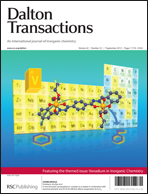A comparative study on the possible zinc binding sites of the human ZnT3 zinc transporter protein†
Abstract
The brain specific zinc transporter protein ZnT3 can be related to the amyloid neuropathology of Alzheimer's disease. In order to analyze the metal binding ability of human ZnT3 protein, here we report a potentiometric and solution structural (UV-Vis, CD, EPR, NMR) study of nickel(II), copper(II) and zinc(II) complexes of three peptides mimicking the possible metal binding sequences of this protein. The peptide L1 (Ac-RHQAGPPHSHR-NH2) is a minimalist, the cyclic peptide L2 (cyclo(Ac-CKLHQAGPPHSHGSRGAEYAPLEEGPEEKC-NH2) is a more complete model of the intracellular His-rich loop, which is widely accepted as a putative metal binding site. The peptide L3 (Ac-PFHHCHRD-NH2) is the model of the conserved cytoplasmic N-terminal –HHCH– sequence. In the physiological pH-range, the ZnL1, ZnH3L2 and ZnL3 complexes are the major species in the corresponding binary systems, with {3Nim}, {3Nim,2/3Oamide} and {3Nim,S−} coordination environments, respectively. The species ZnL3 has 3–4 orders of magnitude higher stability than the other two complexes, indicating the presence of a high-affinity zinc-binding site at the N-terminal tail of the human ZnT3 transporter. Moreover, L3 shows preferred zinc binding as compared to nickel (log β(ZnL3) − log β(NiL3) = 2.3), probably due to the higher preference of zinc(II) for tetrahedral geometry. These facts suggest that zinc binding to the N-terminal –HHCH– sequence of human ZnT3 may be involved in the biological activity of this zinc transporter protein in zinc sensing, binding or translocation processes.


 Please wait while we load your content...
Please wait while we load your content...